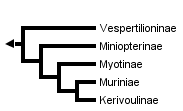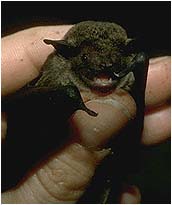Vespertilionoidea
Vespertilionidae
Evening Bats
Nancy B. Simmons and Tenley ConwayWhile there is currently only one family of bats found within in the Superfamily Vespertilionoidea; this rank in the tree has been retained due to the probability that subfamilies within the family Vespertilionidae will be raised to family level in the near future.



This tree diagram shows the relationships between several groups of organisms.
The root of the current tree connects the organisms featured in this tree to their containing group and the rest of the Tree of Life. The basal branching point in the tree represents the ancestor of the other groups in the tree. This ancestor diversified over time into several descendent subgroups, which are represented as internal nodes and terminal taxa to the right.

You can click on the root to travel down the Tree of Life all the way to the root of all Life, and you can click on the names of descendent subgroups to travel up the Tree of Life all the way to individual species.
For more information on ToL tree formatting, please see Interpreting the Tree or Classification. To learn more about phylogenetic trees, please visit our Phylogenetic Biology pages.
close boxIntroduction
The family Vespertilionidae (excluding Antrozoidae and Tomopeatinae) contains almost one-third of living bat species (Koopman, 1993, 1994). Five subfamilies are currently recognized: Vespertilioninae (27 genera, 180 species), Myotinae (2 genera, 86 species), Miniopterinae (1 genus, 10 species), Murininae (2 genera, 16 species) and Kerivoulinae (1 genus, 22 species) (Koopman, 1993, 19994; Volleth and Heller, 1994; Simmons, 1998; Simmons and Geisler, 1998).
All vespertilionids are insectivorous, and most catch their prey in the air while flying. Some species, however, may glean insects off surfaces or trawl with their hind feet across lakes or streams to catch their food.
Characteristics
All Vespertilionidae share the following features:
- nasopalatine duct present.
- left lung undivided.
- m. mandibulo-hyoideus reduced to tendinous band.
- m. geniohyoideus originates by very short tendon.
- curved body of basihyal v-shaped.
- m. occipitopollicalis insertional complex included muscle fibers distal to band of elastic tissue.
Discussion of Phylogenetic Relationships
Five subfamilies are currently recognized in Vespertilionidae: Vespertilioninae, Myotinae, Miniopterinae, Murininae, and Kerivoulinae (Volleth and Heller, 1994; Simmons, 1998; Simmons and Geisler, 1998). Of these, the latter three are each clearly monophyletic (for a list of synapomorphies see Simmmons, 1998). Separation of Myotinae from Vespertilioninae is suggested by chromosome data (Volleth and Heller, 1994) and results of Simmons' (1998) and Simmons and Geisler's (1998) phylogenetic analyses, but DNA hybridization data have suggested that Myotis nests within a clade of vespertilionines (Kirsch et al., 1998). Monophyly of Myotinae (Myotis + Lasionycteris) remains uncertain because no unambigous morphological synapomorphies diagnose this group, and no chromosome data are available for Lasionycteris. Monophyly of Myotis is supported by dervied chromosomal features (Volleth and Heller, 1994), but it is not known if any or all of these traits also occur in Lasionycteris. Monophyly of Vespertilioninae (excluding Myotinae) is also supported only by chromosome data (Volleth and Heller, 1994). Unfortunately, comparable chromosome data are not available for Lasiurini or Antrozoidae, leaving open the possibility that Vespertilioninae may be paraphyletic.
The most comprehensive study of vespertilionid relationships is that of Volleth and Heller (1994), who examined banded chromosomes of Old World representatives of over 20 genera. They found support for monophyly of Vespertilioninae (excluding Myotis). Using Natalus (Natalidae) and Molossus (Molossidae) as outgroups, Volleth and Heller (1994) found support for vespertilionid monophyly with Miniopterinae occupying the most basal branch in the family tree. This contrasts somewhat with Simmons' (1998) and Simmons and Geisler's (1998) tree topology, which placed Vespertilioninae as the basal branch. Volleth and Heller could not resolve the relative relationships of Myotinae, Murininae, and Kerivoulinae, but their results do not contradict Simmons' (1998) and Simmons and Geisler's (1998) findings that Murininae and Kerivoulinae form a clade with Myotinae as their sister-taxon.
Alternative tree from Volleth and Heller (1994):
========= Miniopterinnae
|
| ====== Kerivoulinae
| |
=====| |===== Murininae
===|
|===== Myotinae
|
====== Vespertilioninae
References
Hill, J.E., and J.D. Smith. 1984. Bats: a natural history. Austin: University of Texas Press.
Kirsch, J. A., J. M. Hutcheon, D. C. Byrnes & B. D. Llyod. In Press. Affinites and historical zoogeography of the New Zealand Short-tailed bat, Mystacina tuberculata Gray 1843, inferred from DNA-hybridization comparisons. Journal of Mammalian Evolution.
Koopman, K. F. 1993. Order Chiroptera. In Mammal species of the world, a taxonomic and geographic reference, 2nd ed. D. E. Wilson and D. M. Reeder. Washinton, D. C.: Smithsonian Institution Press.
Koopman, K. F. 1994. Chiroptera: systematics. Handbook of zoology, vol 8, pt. 60. Mammalia, 217 pp.
Simmons, N.B. 1998. A reappraisal of interfamilial relationships of bats. In Bats: Phylogeny, Morphology, Echolocation and Conservation Biology. T.H. Kunz and P.A. Racey (eds.). Washington: Smithsonian Institution Press.
Simmons, N.B. & J.H. Geisler. 1998. Phylogenetic relationships of Icaronycteris, Archeonycteris, Hassianycteris, and Palaeochiropteryx to extant bat lineages, with comments on the evolution of echolocation and foraging strategies in microchiroptera. Bulletin of the American Museum of Natural History. 235:1-182.
Volleth, M. and K. -G., Heller. 1994. Phylogenetic relationships of vespertilionid genera (Mammalia: Chiroptera) as revealed by karyological analysis. Zeitschrift für zoologische Systematik und Evolutionsforschung, 32:11-34.
Title Illustrations

| Scientific Name | Eptesicus furnalis |
|---|---|
| Image Use |
 This media file is licensed under the Creative Commons Attribution-NonCommercial License - Version 3.0. This media file is licensed under the Creative Commons Attribution-NonCommercial License - Version 3.0.
|
| Copyright |
© 1998 Nancy B. Simmons

|
About This Page
Nancy B. Simmons

American Musuem of Natural History, New York, New York, USA
Tenley Conway

University of Toronto at Mississauga, Ontario, Canada
Correspondence regarding this page should be directed to Nancy B. Simmons at
Page copyright © 1997 Nancy B. Simmons
 Page: Tree of Life
Vespertilionoidea. Vespertilionidae. Evening Bats.
Authored by
Nancy B. Simmons and Tenley Conway.
The TEXT of this page is licensed under the
Creative Commons Attribution License - Version 3.0. Note that images and other media
featured on this page are each governed by their own license, and they may or may not be available
for reuse. Click on an image or a media link to access the media data window, which provides the
relevant licensing information. For the general terms and conditions of ToL material reuse and
redistribution, please see the Tree of Life Copyright
Policies.
Page: Tree of Life
Vespertilionoidea. Vespertilionidae. Evening Bats.
Authored by
Nancy B. Simmons and Tenley Conway.
The TEXT of this page is licensed under the
Creative Commons Attribution License - Version 3.0. Note that images and other media
featured on this page are each governed by their own license, and they may or may not be available
for reuse. Click on an image or a media link to access the media data window, which provides the
relevant licensing information. For the general terms and conditions of ToL material reuse and
redistribution, please see the Tree of Life Copyright
Policies.
Citing this page:
Simmons, Nancy B. and Tenley Conway. 1997. Vespertilionoidea. Vespertilionidae. Evening Bats. Version 01 January 1997 (under construction). http://tolweb.org/Vespertilionidae/16140/1997.01.01 in The Tree of Life Web Project, http://tolweb.org/








 Go to quick links
Go to quick search
Go to navigation for this section of the ToL site
Go to detailed links for the ToL site
Go to quick links
Go to quick search
Go to navigation for this section of the ToL site
Go to detailed links for the ToL site